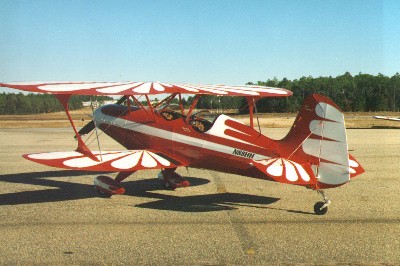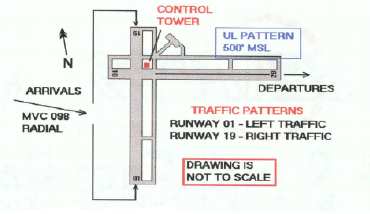
| EAA Chapter 108 |
September 1999
|
Inside This Issue:
Chapter News
Flying the U-2
FAA Drug Testing Policy |
SERFI Approach Procedures
Buck Rado’s Starduster Too
Aircraft for Sale
Heavenly Joke |
Chapter News
SERFI Work Day - SERFI will be holding its first work
day on September 18, 1999. Contact Gerry Poltorak or Jim Jansa for
more information.
September Meeting - The next chapter meeting is scheduled
for September 21, 1999 at 7:00 p.m. The speaker will be Ron Web,
a Viet Nam POW for six years.
Picnic - Chapter 108 is planning a picnic at Ruckel Airport
on September 25, 1999. We will eat at 12:00. Ideas for food
will be discussed at the September chapter meeting.
Treasurer's Report – At the end of August, the chapter
had an account balance of $516.41.
Hands-On Workshop - Chapter 108 is planning a hands-on
workshop for later this fall. We'll be discussing the date and topics
at the next meeting. We've lined up several instructors, but can
always use more. Contact Bob Sutherland for more information or to
volunteer.
Flying the U-2
At the August meeting, Col Dan Wright discussed flying the U-2 along
with the development and original goals of the U-2 program. He revealed
little known facts about some U-2 missions. For example, most folks
know that Francis Powers was shot down over the Soviet Union. Most
folks don't know that a Russian fighter was shot down at the same time
by the same battery of missiles. Although people are familiar with
the Cuban Missile Crisis, it's not widely known that the U.S. lost two
U-2s over Cuba.
The U-2 was notorious for its flying qualities. At altitude, the
margin between Mach buffet and stall buffet was 6-12 knots. During
a turn, this small difference caused one wing to be in stall buffet and
the other wing to be in Mach buffet. Fuel could be pumped between
wings to maintain balance and make landing easier. Navigation was
solely by ded reckoning with an autopilot doing most of the flying.
The highlight of the long tedious missions was listening to radio broadcasts
on the ADF.
…the face of God
A fellow dies and goes to heaven. While he's waiting on St. Peter to
finish the admission paperwork, he notices a large, twin-engine aircraft
approaching the runway there in heaven. The plane comes in too high and
too fast, but the pilot manages to force it onto the runway and ground
loop it. The plane is destroyed, but the pilot gets out and walks away.
A moment later, an identical plane repeats the bad approach and crash
landing. Again, the pilot gets out and walks away. This sequence of events
repeats itself several more times while the man waits.
When St. Peter finally finishes the paperwork, the man asks him, "Who's
the guy in the twin?"
St. Peter replies,"Oh, that's God. He thinks he's a surgeon." ?
Flying “High”
When the FAA recently rewrote CFR 14 Part 135 (FAR 135) they included
a requirement for all sightseeing flight events to fall under the FAA drug
testing requirements of FAR 135.249. All pilots (recreational to
ATP) had to comply with the Part 135 drug testing rules. Since then,
the FAA Administrator has stated the intent of the law was not to require
"charitable" sightseeing events like Young Eagles to fall under the drug
testing rules.
EAA recently received a legal interpretation from the FAA that states
Young Eagle volunteer pilots are exempted from the FAA drug testing requirements
as long as the pilot receives no compensation (including free fuel). EAA
has submitted a Drug Testing exemption request to allow EAA Members to
fly charitable sightseeing flights during Chapter events. EAA expects
the exemption to be approved in September 1999. This will not grant
drug testing exemption status to non-EAA pilots flying at EAA events or
EAA pilots flying at non-EAA events. See pages 6 & 16 of the
Sep 99 Sport Aviation for more.
Like Father, Like Son, Like Son
Bob Ray and his grandson, Dustin Ray, are featured on page 103 of the
September 1999 Sport Aviation. Bob taught Justin to fly in the family
Cessna 140.
$$ For Sale $$
1946 Taylorcraft BC-12D with Continental A65-8. $13,500
/ O.B.O. 2175 TTAF/ 1300 Engine / 40 STOH which included new Millennium
cylinder kit; Rebuilt Stromberg NAS-3A1 carburetor; Rebuilt Bendix Magnetos;
New baffling; New plugs; New engine mounts. Burns 4.1 gph @ 2200
rpm with 24 gal cap, wired position/landing lights / Non-Electric.
Annual 4/00 All logs / No damage history. Contact Chuz at (850) 729-2382
or ChuzBear@aol.com or chamberl@asciet.eglin.af.mil. Photo
on EAA 108 web page.
 Buck
Rado’s Starduster Too Buck
Rado’s Starduster Too
When most folks think of a truly “fun” airplane, they thing of a Cub,
an ultralight, or a biplane. Buck Rado built a truly “fun” plane:
his Starduster Too.
Buck says he always loved airplanes but didn’t get his license until
1976. He promptly bought and restored a 1941 Taylorcraft that he
flew until five years ago.
The Starduster Too was started over 15 years ago from plans and work
proceeded as time and budget allowed. Buck retired several years
ago and went to work on the plane full time for three years. The
first flight took place in January 1998.
The Starduster Too has a tube and fabric fuselage with wooden wing spar
and ribs. A Lycoming IO-360 180hp engine pulls the plane along at
100-105 knots cruise. The panel is almost full IFR with plenty of
gadgets in both cockpits. The eye-catching paint scheme was “borrowed”
from another Starduster in California.
Drop by Milton and see this beautiful plane. While there, look
at Gene Hudkins’ award winning Starduster Too, too.
The New SERFI Arrival Procedure
(Adapted from www.serfi.org)
Temporary Control Tower
The Federal Aviation Administration will operate a temporary control
tower at Middleton Field (GZH) during the following dates and times:
October 8, 1999
Friday 1300 - 1800 CDT
October 9, 1999
Saturday 0800 - 1800 CDT
Middleton Field and the Control Tower will be closed Saturday,
October 9, 1999 from 1400 - 1600 CDT for the air show.
October 10, 1999
Sunday 0800 - 1100 CDT
Frequencies
Evergreen Tower 118.9
Ground Control 121.65
CTAF 122.7 (If tower closed)
Special Arrival Procedure
Unless alternate instructions are issued, the following special arrival
procedure will be utilized for all VFR aircraft inbound to Middleton Field
when the tower is in operation:
 Belleville
VFR Arrival Procedure Belleville
VFR Arrival Procedure
Join the Monroeville (MVC) 098 Radial and then proceed eastbound on
the MVC 098 Radial to Belleville. If navigation equipment is not available,
follow U.S. Highway 84 eastbound to Belleville. Aircraft following U.S.
Highway 84 should remain south of the highway. Monitor Evergreen Tower
for runway information.
Belleville is located approx. 4 miles west of Middleton Field and just
south of U.S. Highway 84. There is a power substation at Belleville and
just north of the power substation you will see a cotton gin with BELLEVILLE
painted on the roof. Contact Evergreen Tower over Belleville and proceed
direct to the midfield downwind for the active Runway (01 or 19).
It is recommended that pilots join this procedure over Monroeville (MVC).
However, pilots may join this procedure at any point west of Belleville.
At Belleville, pilots are expected to be in-trail with traffic ahead (no
side-by-side). Exercise extreme caution for the high volume of traffic
expected between Monroeville (MVC), Belleville, and Middleton Field.
Aircraft without radios follow the Belleville Arrival Procedure and
follow traffic ahead. Inbound IRF aircraft are expected to utilize the
Belleville Arrival Procedure if able to cancel the IRF flight plan in VFR
conditions.
Altitudes and Speed
Maintain 100 knots or less within 10 miles of Belleville and join the
Belleville Arrival procedure at 1500' MSL. If aircraft cannot safely maintain
100 knots, maintain 150 knots and join the Belleville Arrival procedure
at 2000' MSL. Maintain these altitudes and speeds until entering the downwind
or as directed by the tower. Exercise extreme caution for the high volume
of aircraft inbound to the airport. Remain in-trail of aircraft ahead.
Special Departure Procedure
To the maximum extent possible during the periods that the tower is
in operation, departure traffic will be expected to utilize Runway 10.
Due to the volume of traffic arriving on Runway 01 or 19, departure traffic
on Runway 10 should expect to depart from the intersections east of Runway
01 or 19 (approximately 3,000' of runway available). After departure, continue
straight ahead until four miles east of the airport before turning on course.
Do not over fly the airport below 3,000'. Exercise extreme caution for
traffic inbound from the west.
Ultralight Arrival and Departure Procedures
All arriving and departing ultralight vehicles enter/exit to/from the
north/northeast of Middleton Field (GZH) and remain below 500 feet above
the ground. Remain clear of the arrival end of Runway 19. Ultralight vehicles
will use the eastern 2000 feet of the east/west taxiway for their operations
(see graphic). Use left or right hand traffic north of the taxiway. Communication
with the control tower is not required.
Parking Information
After landing, aircraft should exit the runway as expeditiously as
possible unless otherwise directed by the tower. Flagmen (Wearing Orange
Vests) will direct aircraft to parking. Use of the parking signs will aid
the flagmen. The sign should be of light color with LARGE dark lettering
that can be read from at least 50 feet away. Please display this sign in
the left side of your windshield.
Abbreviation for parking signs:
ACC - Antique Classic Contemporary
GAC - General Aviation Camping
GAP - General Aviation Parking
HB - Home Built
WB - Warbird Parking Area
Calendar
September 18, 1999 - SERFI Work Day
September 21, 1999 - Monthly Chapter Meeting
September 25, 1999 - Picnic at Ruckel Airport
October 8-10, 1999 - Southeast Regional Fly-In (SERFI)
at Evergreen, Alabama.
October 19, 1999 - Monthly Chapter Meeting
|


